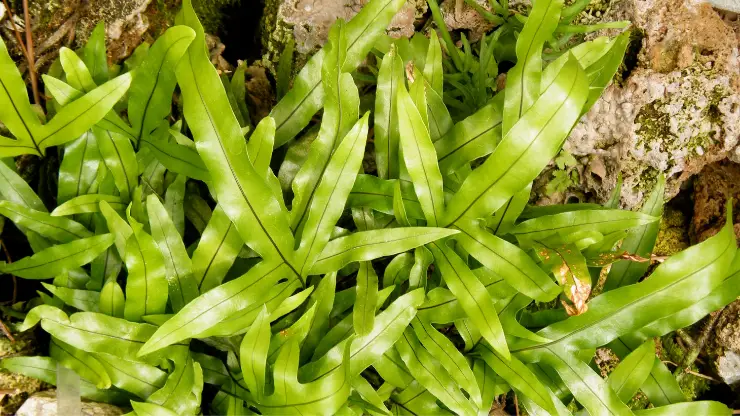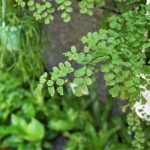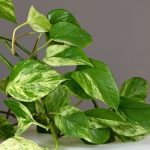When we saw a struggling Kangaroo Fern in the clearance section of Lowe’s a few weeks ago, we bought it – even though it had seen better days. We figured out how to revive it, and now it’s thriving. Kangaroo Paw Fern (Microsorum diversifolium) isn’t too hard to care for indoors, but there are a few things than can cause the plant distress.
So, why is your kangaroo fern dying? The most common reasons include too little (or too much) sunlight, not enough water or allowing the soil to become too dry, low humidity, frequent overwatering, exposure to temperatures below 50 degrees or above 75 degrees, and pest infestation.
Considered one of the easiest indoor ferns to grow, even a dying kangaroo fern can be saved if it still has some healthy fronds left. Let’s look at common problems and how you can fix them.
Too Little or Too Much Sunlight
The Kangaroo Fern can tolerate low light conditions, but there won’t be much growth. The foliage will thin out as older fronds die off and new ones are slower to emerge. In low light, new fronds will appear with fewer “fingers” on the “paw” and a simpler structure. See our article on determining if your plant is getting enough sun for more information.
Too much sunlight, on the other hand, can burn the delicate fronds and cause browning. Kangaroo fern cannot tolerate direct sunlight. As with most ferns, you’ll need to get the amount of light just right for the best results.
SOLUTION: Place your plant in a bright, north- or east- facing window. Do not grow Kangaroo Fern directly in a south-facing window. If necessary, move back a few feet from a south-facing window to protect the delicate foliage from direct sunlight while still allowing adequate indirect light. A sheer curtain placed over a window will help filter the light if you suspect your plant is getting too much.
Too Little or Too Much Water
Inadequate water or overwatering can both cause your Kangaroo Fern to decline. You can wait for the soil to dry out completely between waterings and the plant won’t die, but this is not advisable. Like most types of indoor ferns, this one prefers slightly moist (but not wet) conditions.
Overwatering can cause a build up of salts in the soil. If you notice a white substance on the soil surface, you may be watering too much. Mushy or black roots are also a sign of overwatering.
SOLUTION: Keep the soil evenly moist but not wet. Wait until the top of the soil feels just barely moist (not completely dry) before watering. If the soil becomes completely dry, use a chopstick to gently aerate it before watering again. This allows the water to more evenly penetrate. Never allow the plant to sit in water, as it may develop root rot – especially in areas with high humidity.
If you’ve overwatered, take the plant out of its pot and inspect the roots. Cut off any mushy or black roots, place the plant on newspaper and allow it to dry out before repotting.
Low Humidity
Kangaroo Fern is native to Australia and New Zealand, where it would typically grow in areas where relative humidity is very high. Although it can tolerate spells of lower household humidity, it can begin to droop and wilt if the air around the plant is too dry for too long.
SOLUTION: Run a humidifier near your Kangaroo Fern or nestle it between other plants with similar care requirements. Another option is to set the plant in a tray filled with pebbles and water – making sure not to allow the plant to stand in water. Add water to just below the tops of the pebbles.
Click here to see our favorite plant humidifier on Amazon. We’ve used this one for years and it keeps all the indoor air near our houseplants at an ideal humidity level (40 – 60 percent) without much extra work on our part. Plus, it’s inexpensive and very easy to clean.
Avoid placing Kangaroo Fern near fireplaces, furnaces, woodstoves, and other heating appliances that dry the air.
Improper Temperatures
Kangaroo ferns will not thrive (and may even die) if temperatures frequently rise above 72 degrees F or drop below 50 degrees F. They need warm temperatures all day, year-round. If they become too hot or too cold, you’ll likely notice yellowing and dropping leaves.
SOLUTION: Keep your fern in an area with daytime temperatures of 68 to 72 degrees and night temperatures of 50 – 55 degrees for the best results. Most of the time, a comfortable indoor temperature for your home will be adequate for Kangaroo Fern too. Just avoid drafty areas where the plant might become too cold and very warm areas near heaters and fireplaces.
Pests and Diseases
If you’ve ensured your Kangaroo Fern has adequate sunlight, enough water, consistent humidity, and proper temperatures but you’re still experiencing a decline, it could be due to a disease or pest infestation.
The most common culprits are scale – sap-sucking insects that attach themselves to the leaves and branches of host plants – and mealybugs. Infestation causes yellowing leaves and reduced growth. You’ll know you have a problem if you see any of the following symptoms:
- Small brown bumps on the leaves – especially on the veins (scale)
- White, fuzzy mildew-like growth on the leaves (mealybugs)
Scale insects tend to cluster together on the leaves and you may not even notice you have an infestation until the population becomes quite large.
SOLUTION: Cut off and dispose of any infested branches and leaves. If you have a small infestation, you can pick off the insects by hand or dab individual pests with a cotton swab soaked in alcohol. For larger infestations, use an insectice indicated for getting rid of scale or mealybugs or even let some live ladybugs loose in your house.
Ladybugs are natural predators of scale and mealybugs. You can buy live ones on Amazon – then let them get rid of your infestation for you! This is a green, organic solution if you prefer not to use chemicals.
We have successfully used Garden Safe Houseplant Garden and Insect Killer to get rid of both scale and mealybug infestations on various houseplants – including ferns. I always keep a bottle of it on hand. It’s safe, inexpensive, and effective, and we highly recommend it. You can view the product on Amazon to see the current price or check your local nursery or home improvement store.
Related Questions
How do you take care of a Kangaroo Fern? Place in a north- or east-facing window to provide bright, indirect sunlight, keep soil moist but not wet – watering only when the top of the soil feels barely moist to the touch, keep humidity levels moderate to high (use a humidifier if your home is dry), and feed once a month during active growth with a balanced houseplant fertilizer.
How do you repot a Kangaroo Fern? Wait until early spring just before new growth begins. Remove from the current pot by grasping at the base of the stems and gently pulling up. Place the root ball a new pot at least 2 inches larger in diameter on top of a few inches of potting soil. Pack soil around the roots, water thoroughly, and feed with a water-soluble fertilizer.







